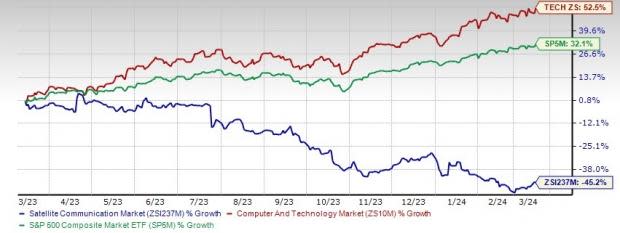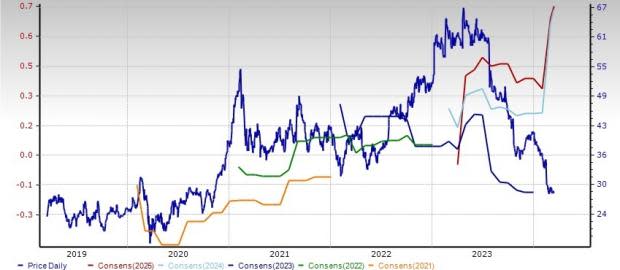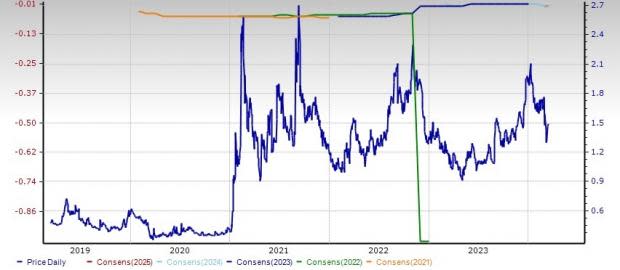3 Stocks to Watch From the Satellite and Communication Industry
Companies within the Zacks Satellite and Communication industry are well-poised to benefit from a vast proliferation and cheaper access to space technology in the long run. This trend is leading to a diversification in end-market users. AI, Machine Learning and Big Data have given rise to multiple use cases across industries like oil and gas, agriculture, transportation and non-governmental organizations. Geopolitical competition in space as a contested domain is boosting investments by global militaries. Iridium Communications IRDM, Globalstar GSAT and SES S.A. SGBAF, have significant growth potential on global security threats, surging defense budgets and demand for high-quality imagery and value-added services. However, global macroeconomic challenges, inflation and supply chain dynamics could affect growth prospects of these companies.
Industry Description
The Zacks Satellite and Communication industry comprises space technology companies that provide satellite imagery, intelligence services and spacecraft and robotics for space exploration, research and national security. They help customers understand and navigate the evolving planet, deliver global broadband communications and explore space. Industry players provide communication services to media businesses, fixed and wireless telecommunications operators, data networking providers and Internet service providers. They also offer commercial satellite communication services to government and military organizations. The firms offer satellite-based consulting and technical services, including the lifecycle of satellite operations and infrastructure, ranging from satellite and launch vehicle procurement to telemetry and commanding services.
What's Shaping the Industry's Future
Advancements in Technology Hold the Key: There has been a radical change in highly-specialized satellite manufacturing patterns. More emphasis is put on using ordinary buses and computer-aided design tools to customize the communications payloads. A mass-produced system is adopted and several satellites are manufactured in an assembly line. Integration and testing have become highly automated. The extent of testing is lowered after prototyping and initial production is completed. Countries with comprehensive space programs have distinct military, economic and scientific advantages. However, complexity and barriers to entry into space have allowed only a few to develop notable capabilities. The demand for small satellites across regions is expected to increase over time. North America has the bulk of the market share, followed by the Asia Pacific, Europe and the rest of the world. North America maintains its dominance with the highest number of small satellite launches by government end users. The companies continue to align their products and services with the U.S. Department of Defense’s National Defense Strategy needs and the growing international defense and intelligence demand.
Subscriber Momentum to Drive Growth: Wide proliferation and cheaper access to space technology have diverse end-market users. The companies share a strategic relationship with various government organizations, including military and disaster response agencies and non-governmental organizations, to provide robust, tactical, real-time voice and low-latency data command and control communications. A comprehensive product portfolio enables companies to expand their customer base and offset the losses from one product category with benefits from another. High product quality increases brand loyalty and enhances performance in a competitive market. For civil customers, notably NASA, growth is being driven by space exploration programs. For commercial customers, growth drivers include a strong demand for imagery due to new use cases, space-based remote sensing, Geosynchronous Equatorial Orbit (GEO) replacement demand and Low Earth Orbit (LEO) communications programs. Also, personal satellite communications are witnessing strong demand, leading to subscriber growth.
Spending on Space Infrastructure Could be Affected by Macroeconomic Weakness: With more than half of the revenues from U.S. government customers, the industry will likely benefit from increasing defense and space infrastructure budgets. The explosion of space-based intelligence, surveillance and reconnaissance and communications is expected to boost government investments in the sector. However, weakness in global macroeconomic conditions could compel customers to lower spending, which does not bode well for industry participants. Volatile supply chain dynamics and inflation could lead to higher costs and increased lead time, which are major concerns. The inflow of capital investment to this industry will likely be affected if there are more interest rate hikes. Also, investor uncertainty amid a broader market slowdown is concerning.
Zacks Industry Rank Indicates Bright Prospects
The Zacks Satellite and Communication industry is housed within the broader Zacks Computer and Technology sector. It currently has a Zacks Industry Rank #27, which places it in the top 11% of more than 252 Zacks industries.
The group’s Zacks Industry Rank, which is the average of the Zacks Rank of all the member stocks, indicates bright near-term prospects. Our research shows that the top 50% of the Zacks-ranked industries outperform the bottom 50% by a factor of more than 2 to 1.
Before we present a few satellite and communication stocks you may want to consider for your portfolio, let’s look at the industry’s recent stock market performance and valuation picture.
Industry Underperforms Sector, S&P 500
In the past year, the Zacks Satellite and Communication industry underperformed the S&P 500 composite and the broader Zacks Computer and Technology sector.
The industry has lost 45.2% over this period against the S&P 500’s increase of 32.1%. The broader sector moved up 52.5%.
One-Year Price Performance

Industry's Current Valuation
The Enterprise Value-to-EBITDA (EV/EBITDA) ratio is commonly used for valuing satellite and communication stocks. The industry has a trailing 12-month EV/EBITDA of 11.72X compared with the S&P 500’s 14.87X. The sector’s trailing 12-month EV/EBITDA stands at 13.95X.
In the past five years, the industry has traded as high as 24.30X and as low as 4.21X, with a median of 7.97X, as the chart below shows.
Enterprise Value-to-EBITDA Ratio (Past Five Years)


3 Stocks to Watch in the Industry
Iridium Communications: Iridium is a satellite communications company that offers dedicated commercial global voice and data communications services to both businesses and governments in the U.S. as well as globally. It also works with non-governmental organizations.
Iridium's performance is gaining from higher engineering and support revenues (due to a rise in activity with the U.S. government) and momentum in commercial business lines. Going ahead, the company expects engineering and support revenue to increase in 2024 owing to ongoing work on the Space Development Agency contract. The company is likely to witness the growing adoption of its mid-band as well as benefit from the introduction of a new IoT transceiver late in 2024. It expects $3 billion in shareholder returns by 2030.
However, 2024 revenues are expected to fall by $9.1 million due to the extension of satellites' estimated useful lives by five years. The company expects lower growth in commercial, voice and data business in 2024. Stiff competition and leveraged balance sheet are concerns.
Iridium carries a Zacks Rank #1 (Strong Buy). You can see the complete list of today’s Zacks #1 Rank stocks here.
The consensus estimate for its current-year earnings is pegged at 72 cents, up 148% in the past 30 days.
Price and Consensus: IRDM

Globalstar: Headquartered in Covington, LA, Globalstar offers satellite voice and data services to commercial and recreational users in more than 120 countries worldwide. Globalstar's products include mobile and fixed satellite telephones, simplex and duplex satellite data modems and flexible service packages. Globalstar serves various sectors like oil and gas, government, mining, forestry, commercial fishing, utilities, military, transportation, heavy construction, etc.
The company’s efforts to boost the development of its spectrum and wholesale capacity services bode well. Increasing service revenues (including growth in Commercial IoT) and improved adjusted EBITDA resulted in healthy guidance issuance for 2024.
Momentum in XCOM RAN systems also bodes well. The company recently won its first order for delivery of multiple XCOM RAN systems to support warehouse automation for a major U.S. retailer.
Management expects total revenues for 2024 to be in the range of $225-$250 million. The company reported revenues of $223.8 million for 2023.
The Zacks Consensus Estimate for this Zacks Rank #3 (Hold) stock’s current-year earnings is pegged at a loss of 2 cents compared with a loss of 1 cent reported in the previous year.
Price and Consensus: GSAT

SES S.A: Based in Luxembourg, SES S.A provides satellite broadband communications services. It offers video services, such as broadcasting, content distribution and occasional use and full-time video contribution services. The company also provides enterprise services, including enterprise broadband, infrastructure as a service, bandwidth and customized connectivity and tailored services.
The company is gaining from strong growth in the Networks revenue segment, which contributed 52.3% to total revenues in 2023. The segment revenues were up 6.1% year over year. This is mainly due to growth in mobility revenues (owing to expansion of services to cruise lines) which were up 11.5% year over year in 2023.
SGBAF carries a Zacks Rank #2. The Zacks Consensus Estimate for the stock’s current-year earnings is pegged at earnings of 61 cents per share, unchanged in the past 30 days. The company had reported earnings of 55 cents in the previous year.
Want the latest recommendations from Zacks Investment Research? Today, you can download 7 Best Stocks for the Next 30 Days. Click to get this free report
Iridium Communications Inc (IRDM) : Free Stock Analysis Report
Globalstar, Inc. (GSAT) : Free Stock Analysis Report
SES S.A. (SGBAF) : Free Stock Analysis Report

 Yahoo Finance
Yahoo Finance 